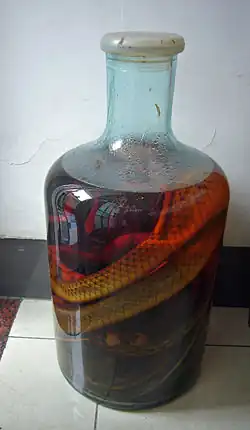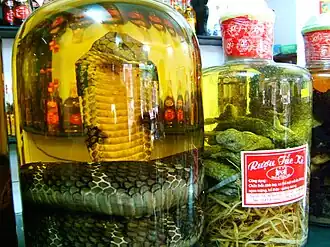Snake wine


Snake wine (Chinese: 蛇酒; pinyin: shé-jiǔ; Vietnamese: rượu rắn; Khmer: ស្រាពស់, sra poas; Korean: 뱀술, baemsul) is an alcoholic beverage produced by infusing whole snakes in rice wine or grain alcohol. The drink was first recorded to have been consumed in China during the Western Zhou dynasty (c. 1040–770 BC) and believed in folklore to reinvigorate a person according to Traditional Chinese medicine.[2] It is a traditional drink in much of East Asia and Southeast Asia.
The snakes, preferably venomous ones, are not usually preserved for their meat but to have their "essence" or venom dissolved in the liquor. The snake venom proteins are unfolded by the ethanol and therefore the completed beverage is usually, but not always, safe to drink.[3]
History
Consumption of snakes and their viscera has long been considered by followers of traditional Chinese medicine to promote health. Snake wine was first recorded to be used in China during the Western Zhou dynasty (771 BC) and the supposed medicinal use of snakes was noted in the medical manual Shen nong ben cao jing (神農本草經) compiled between 300 B.C. and 200 A.D.[4] The detailed uses of various snake feces, their body parts, and various preparations were elaborated in Li Shizhen's Bencao Gangmu (本草綱目).[5] Snake bile was offered to the Chinese Ming dynasty statesman Yang Jisheng as treatment for the injuries he suffered in prison circa 1554.[6]
In culture
In Vietnam, the common regional name for snake wines is rượu thuốc, while less common ones are referred to as rượu rắn.[7][8] A similar drink is made with dehydrated geckos or sea horses rather than snakes.[9] It is illegal to import snake wine to many countries because many of the snakes used for its production are endangered species.[10] Snake liquor, made with asps infused in grain alcohol, is a specialty in North Korea.[11]
Health risks
The risks of ingesting snake wine include systemic envenomation from the contained venom, which may present features differing from direct envenomation by snakebite. A number of health problems of the vascular system may result, including damage to the vascular wall endothelium, abnormal platelet function, and coagulopathy.[3]
See also
References
- ^ "The Last Days of the Mekong Snake Hunters". 9 August 2016. Archived from the original on 13 October 2016. Retrieved 26 August 2016.
- ^ 蛇酒的泡制与药用 [The production and medicinal qualities of snake wine], 2007-04-09, archived from the original on 2011-07-06, retrieved 2009-10-20
- ^ a b Moon, Jeong Mi; Chun, Byeong Jo (2016-06-01). "Severe Coagulopathy after Ingestion of "Snake Wine"". The Journal of Emergency Medicine. 50 (6): 848–851. doi:10.1016/j.jemermed.2015.11.037. ISSN 0736-4679. PMID 26823133 – via Elsevier Science Direct.
- ^ 关, 海珊 (2008-01-22), 趣谈蛇酒的来历与药用价值 [Leisure conversations on snake wine, its history and it medicinal properties], archived from the original on 2009-12-13, retrieved 2009-10-20
- ^ 李, 時珍 (1578–1593), 本草綱目 [Compendium of Materia Medica], archived from the original on 2012-02-22, retrieved 2009-10-20
- ^ Hammond, Kenneth J. (2012) [First published 2007 by Kegan Paul International]. Pepper Mountain: The Life, Death, and Posthumous Career of Yang Jisheng. New York, NY: Routledge. p. 69. ISBN 978-0-415-54189-3.
- ^ Galván, J.A. (2014). They Do What? A Cultural Encyclopedia of Extraordinary and Exotic Customs from around the World: A Cultural Encyclopedia of Extraordinary and Exotic Customs from around the World. ABC-CLIO. p. 294. ISBN 978-1-61069-342-4. Retrieved 7 June 2021.
- ^ Wick, Anemi (2 September 2018). "Vietnam's famous alcohol aphrodisiac can boost your sex drive – but do you have any idea what's in it?". South China Morning Post. Archived from the original on 7 June 2021. Retrieved 7 June 2021.
- ^ Mandel, Peter (April 22, 2007), Snake Wine, The Washington Post Company, archived from the original on November 3, 2012, retrieved October 26, 2017
- ^ Rich Phillips (May 7, 2009). "Name your poison: 'Snake wine' seized at airport". CNN. Archived from the original on 20 September 2017. Retrieved 22 May 2016.
- ^ Fischer, Paul (2015). A Kim Jong-Il production: the extraordinary true story of a kidnapped filmmaker, his star actress, and a young dictator's rise to power (1st ed.). New York: Flatiron Books. pp. 2–3. ISBN 978-1-250-05426-5.
They drank cognac, champagne, soju (rice liquor), and other North Korean specialties such as ginseng wine, with the roots still twisting inside the bottle, and snake liquor, a thick, venomous asp infusing in each jar of grain alcohol.